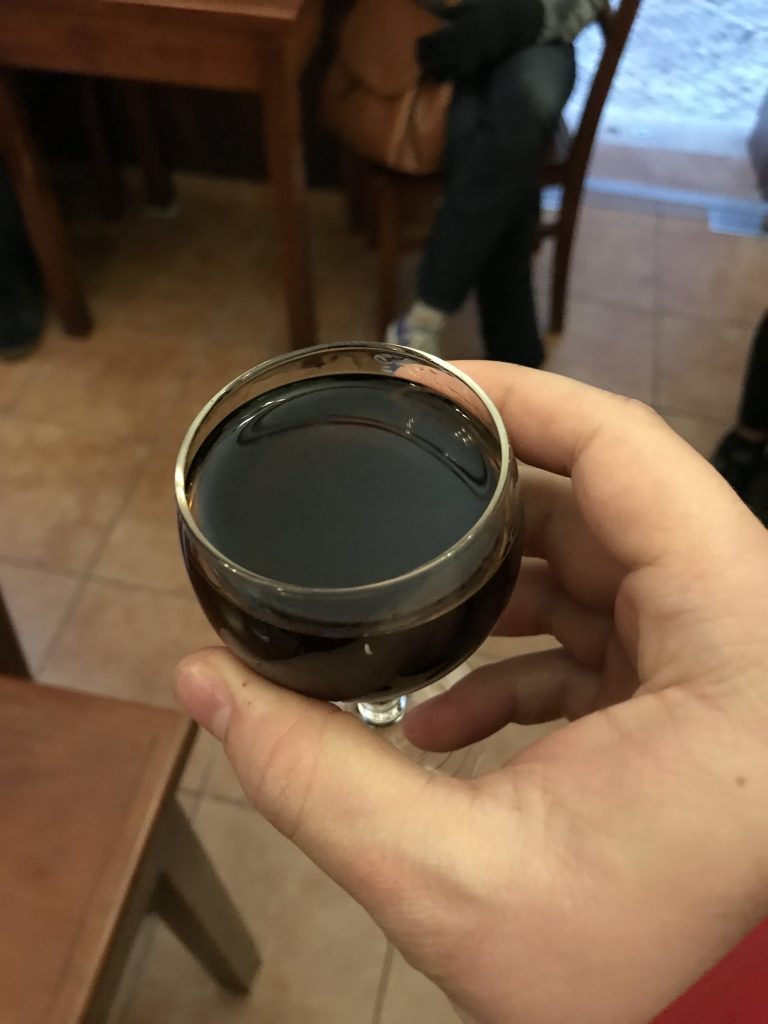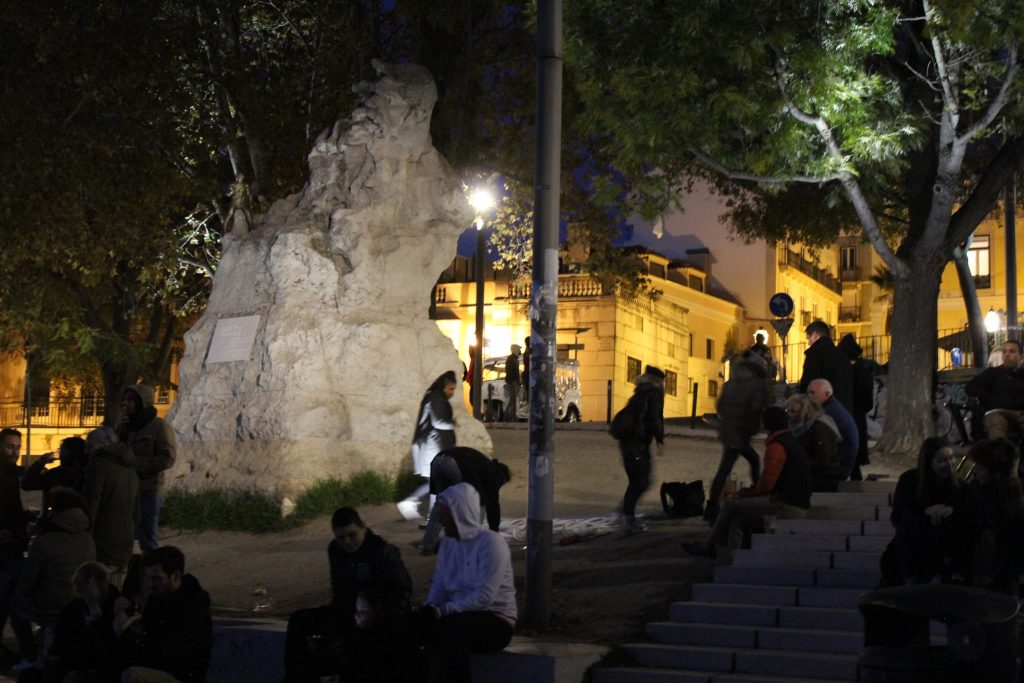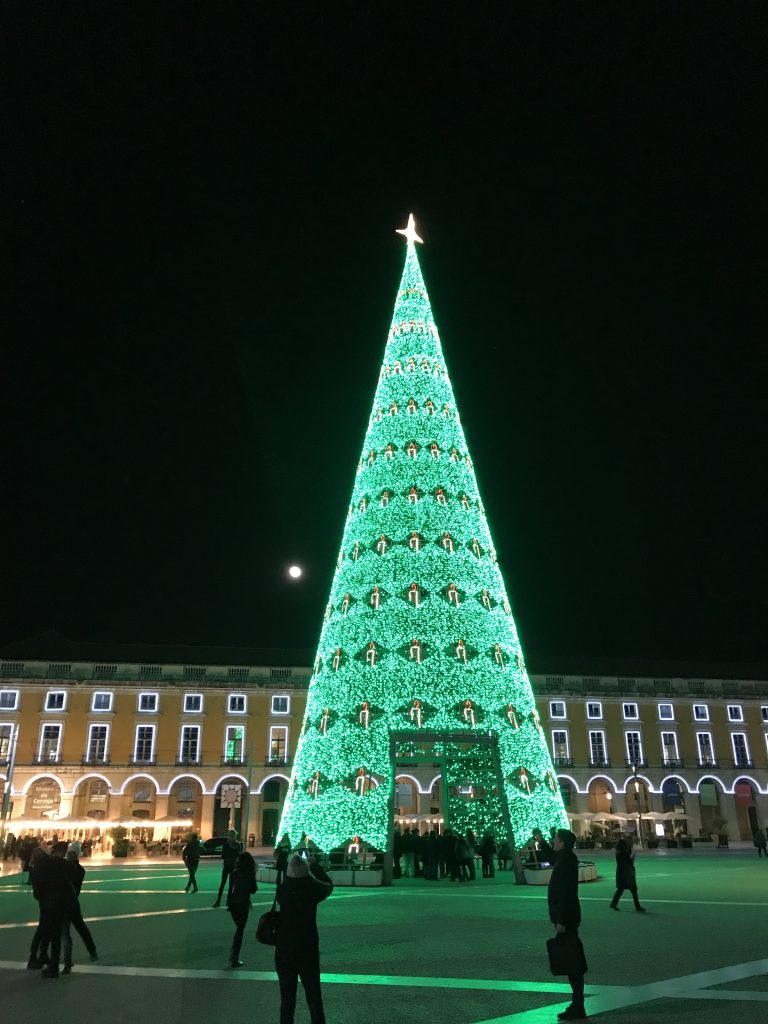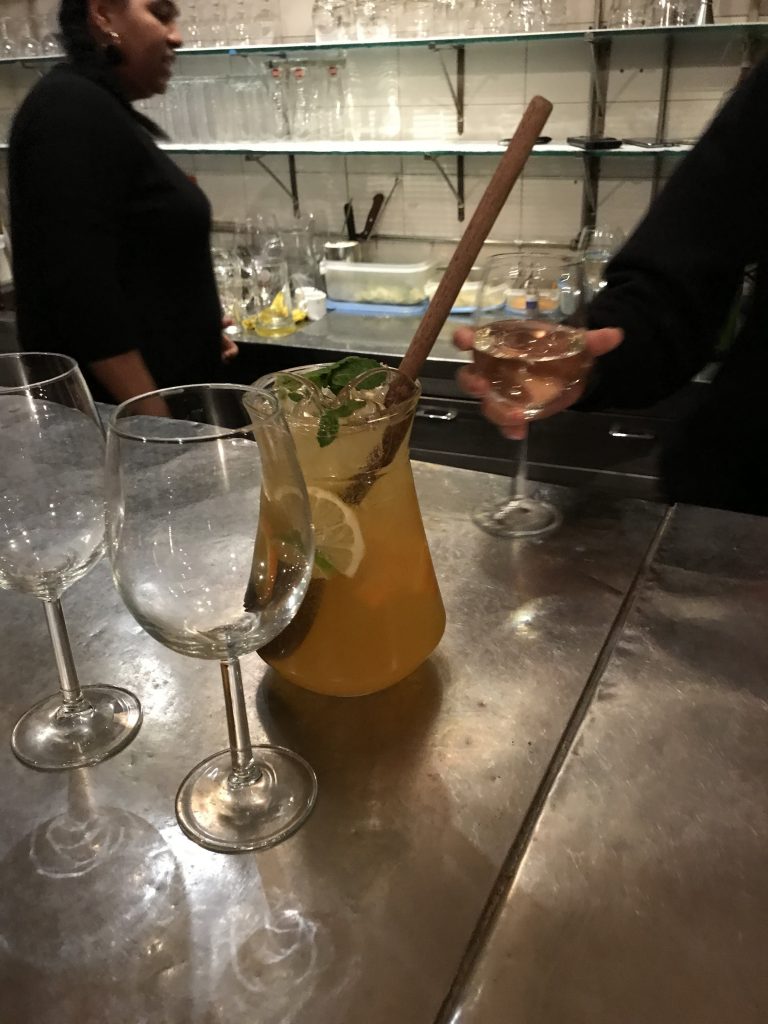We decided to take the Bairro Alto and Chiado Free Walking tour (Discover Lisbon) at 330PM, which meant we had a little time to grab lunch. Starbucks was the easiest so we paid for 2 caprese sandwiches and rested for a bit before meeting our guide at Rossio Square (where the Christmas market from the previous night was held). We had just enough time to grab a treat from the market.

The meeting point was easy to find – we just had to look for the yellow umbrella and yellow shirts. Our guide, Eduardo, was a PhD cultural anthropology student doing his dissertation on the Thai islands of Phi Phi and its unique expat lounge culture. He was full of energy and a bastion of knowledge. Brendan previously has mentioned that the best guides he has had on these free walking tours (offered by many cities) are usually university students. Eduardo did not lead us astray as we headed to Bairro Alto.
We learned about the Lisbon earthquake of 1755 and how it devastated the city on a Sunday and All Saints Day to boot, when everyone was in church (except for the Muslims and the Jews) lighting candles. The earthquake led to a tsunami that wiped out everything up to Rossio Square, and the candles lit in the churches contributed to widespread fires after the earthquakes. The earthquake was an 8.5 on the Richter scale and was supremely devastating – 10,000 to 100,000 people died. Many people, after the earthquake, rushed to the docks and safety, only to be swallowed by a 40 foot tsunami. Ironically, the Muslim and Jewish quarters were left mostly in tact due to better construction, avoidance of the fault line, and nobody lighting candles. 85% of the city was lost.
This was during the age of the Spanish Inquisition, which Portugal had held on to even in the face of the Enlightenment that was unfolding elsewhere in Europe.The earthquake, however, is what allowed Lisbon to shed it’s religiously dominated past and move to a secular state – in effect saving the country and allowing it to move forward.
One of the heroes of this time period was a Marquis, Sebastião e Melo, who was tasked with rebuilding the city by the king after the royal family fled in fear of the ensuing mayhem. Eventually King Joseph I of Portugal came back to Lisbon, but his fear of the earthquake led to building a residence with large amount of open spaces on the top of the hill in Ajuda. He basically left the city in the hands of Melo to heal, rebuild, and govern.
Melo was an enlightened thinker who brought a secular view of the world to Lisbon and ushered in modernity. He rebuilt the city beyond its former glory and indulged in architecture (including earthquake proof building techniques), art and craft-work, pressing any able-bodied citizen into the repair work of the city. Baixa was totally rebuilt with the wide streets we walked on during our trip.
And, the rebuilding of Lisbon also further capitalized on the age of the Portuguese explorers and occupation of Brazil. Much of the art in Lisbon was reflective of the colonial architecture and exploration on the sea, such as the wave mosaics on the floor of Rossio Square.
Additionally, since almost all the churches in the city were destroyed on an important holiday, this led the people to abandon some of their Roman Catholic tradition and to embrace the Age of the Enlightenment. Even so, De Melo still invested in churches as an art form and also as an answer to the gorgeous Italian churches built in the same time period, essentially to put Lisbon on the cultural map. One such church we saw was the Church of Sao Roque, which was build using solid gold on the interior (as opposed to just gold plated).

Church of Sao Roque in Bairro Alto
Unfortunately for Melo, the next ruler of Portgual, Queen Maria I, was super religious and wanted a return to the Church. She put a restraining order on an dexiled Melo outside of Lisbon despite his heroic efforts after the earthquake and his role in making Lisbon a modern, enlightened city. Wah wah.
Another interesting story that Eduardo told was the story of King Sebastian. He was a child King whose nickname was “the desired” – for his wealth, good looks and youth. He was born in 1554, and wanted to bring wealth and riches to all the people of Portugal from conquests in Brazil and Africa. His grand plan was to invade Morocco on a Crusade and use this as a launching point to exploit Africa. He put an army together for the invasion and, in alliance with Abu Abdullah Mohammed II, who had around 6,000 Moorish soldiers met the Moroccan general Abd Al-Malik. Sebastian’s army was totally decimated, and he is thought to have died during that battle – however his remains have never been found. There’s a legend and idiom now in Portugal that whenever the fog comes in, it may be the herald of the return of King Sebastian bringing riches for the everybody. Politicians also used the phrase “waiting for Sebastian” today when referencing populist strategies of a quick pay-off.
This building, the train station, used to have a statue of King Sebastian – but a tourist tried to take a selfie with it, got too close, and the statue fell over.

Bairro Alto train station with King Sebastian statue that fell over
We continued up the winding steps into the heart of Bairro Alto, and found ourselves first in this square. Firstly, the fountain in the middle is safe for drinking.
Second, there is a royal guard posted outside on of the museums on this square in honor of the Carnation Revolution, a bloodless revolution on April 25, 1974. The army staged a coup over the authoritarian dictator Marcello Caetano, who had recently replaces despot Salazar. It was named the carnation revolution because a flower lady on the square had given a carnation to one of the soldiers, who decided to put it in the end of his rifle. All other soldiers followed suit, making it a profitable day for the flower vendors.

After the Carnation Revolution, all previous squares, bridges, and streets named after King Sebastian were renamed 25th of April. Eduardo pointed out that Lisboans loved to reuse and remake historical landmarks.
We then walked up to a panoramic viewpoint of the city, passing by these arches.

Bairro Alto arches
After another climb (and not paying 4 Euros for the elevator), we were rewarded with some beautiful views of Lisbon.

A person from our tour group mentioned that the locks people placed on the chain-linked fence actually came from a trend in Italy around making love promises. I had never seen them before and Eduardo seemed annoyed by them, but I thought they were interesting.

We then headed deep in to Barrio Alto for a discussion on Fado, which we had recently experienced the previous night. The streamers were in place from the other Valentine’s Day holiday they have in June, where 10 local couples about to get married get sponsored by the government for their honeymoon. We took a picture of the place we would return to later that night for a wonderful Fado experience.
We took a picture of the place we would return to later that night for a wonderful Fado experience.

Then, we walked up the main street in Bairro Alto onto the main square in that neighborhood called Camões Square, which is the dividing line between Chiado and Bairro Alto. This was a good landmark for us later on. The statue in the middle was of Camões, an acclaimed Portuguese poet who lost his right eye in a battle. He a Portugese writer who put Portugal on the map for poetry and literature by penning the adventures of Vasco De Gamo, the great Portugese explorer. The story goes that Camões was on a sinking ship off of Cambodia and was faced with the choice of saving his precious manuscript or his Chinese lover. He chose the manuscript.

We had a quick stop at a statue of one of the most famous Portuguese writers and poets, who was also a schizophrenic, getting most of his ideas from letters from himself to himself (ass someone else). Note to self – check out Fernando Pessoa later.

We had one more panoramic view to enjoy before the sun went down, in another nice square after we visited the gold inlaid church. We even found another Christmas market (but no unique ornaments).

Bairro Alto views
We could have taken a small trolley up to get to this viewpoint for 2 Euros each way (to go approximately 100 meters).

Towards our last stop in Bairro Alto, we had some of the local Ginja at pub on the way. Ginja was invented by a Franciscan monk from a local monastery. It was made from fermented sour cherries that are then sweetened. It tasted like cough syrup and was quite nice for my dry and soar throat.


We headed through the Bica neighborhood, which was named for Brazilian coffee that needed sugar (Bica means with a little sugar).

We passed through the area of the drug dealers and the only sketchiness we actually saw in Lisbon and made our way to our last stop, Miradouro de Santa Catarina. On our way we passed a grove of orange trees, which were used to mask the scent of people throwing buckets of waste from upstair apartments in the bitter cold of winter.

This was a promenade overlooking the Tagus river and the waterfront that had the statue of Vasco de Gama fighting a giant, symbolizing the Portuguese people’s defiance to nature and the travails of exploration. The statue came from the writer Camões (whose square we were in earlier),
You can see in the distance a replica of Christ the Redeemer, which Lisbon erected to match Brazil’s version as a symbolic gesture of friendship (even though it’s facing a way from Brazil).
I liked this little are a lot – it was vibrant, young, and full of musicians.

At the end of the tour we gave Eduardo $40 and said goodbye. We had a quick stop back in Baixa to shower, change, and rest. Then we headed out to dinner on the waterfront in the trendy, hipster food hall, Mercado Da Ribeira.
We stopped first at another beautiful square with Christmas lights.


Then, on to the market for dinner. We were just getting hungry around 830PM when we arrived.

We decided on two Portugese food stalls in the back that offered Portugese fusion high-end cuisine. We ended up with some green wine (Vinho Verde tasted like white wine), caldo verde soup, a pork sandwich (for CJ), and Francesinha. Francesinha is like Portugese lasagna – with bread, wet-cured ham, linguiça (pork sausage), a hot thick tomato , and steak covered with melted cheese and beer sauce.

We really enjoyed this experience as it gave us a chance to see the merger of the past and the future as far as the culinary culture goes. And, the market was festively decorated as well to match the rest of the city.
Then, we walked back to Bairro Alto for Fado. We decided on A Tasca do Chico on the street we had visited earlier. We were going back and forth between a Fado house and a Fado restaurant. Fado restaurants required you to eat and the food was typically not that good, whereas the Fado was of a higher quality. Fado houses allowed you to drink only, but were more packed, could not be reserved, and had slightly lower quality or emerging Fado artists.

The experience was chaos at first. We got there around 935PM, just before the Fado would begin again at 10PM. It was a good thing we got their so early before the next set – it was already packed but we luckily found a spot right at the edge of the bar. We ordered some white sangria which was phenomenal.

The house closed the door and turned the lights down, signaling that the Fado was about to start. A gentleman we had seen earlier circulating the floor moved to a center position nearby a bench containing two guitarists and began to sing. We caught two of his sets. After his first set I was able to spot two seats opening up on a bench more towards the center so we moved from the bar with our drinks. Here’s a picture from his second set.

In between sets we got to know our table mates. One lady was a solo traveler from Taiwan by way of Brooklyn, and another lady was also a solo traveler, Katie, from San Francisco. Fado was a very intimate experience, smashing a bunch of strangers together from both around Lisbon and the world into a Petri dish of artistic expression and experimentation.
The highlight for both Brendan and me was the lady Fado singer, an up and coming artist who was being introduced in to the Fado scene (at least that’s what I could gather from the introduction of the male Fado singer in Portuguese). She regaled us for 15 minutes of song before another break.

She was magical. If you have never heard Fado before, I encourage you to check it out. As I mentioned in a previous blog, it’s dripping with the emotion of loss.
Here’s a live video of our Fado experience in Bairro Alto:
After a great day and a great night, we headed back to our pad in Baixa to sleep around midnight. We had a long and early day back to the US the next day, and it was a disaster of a travel day.
